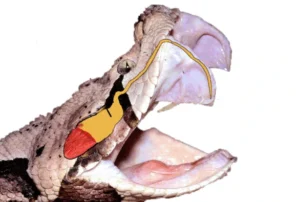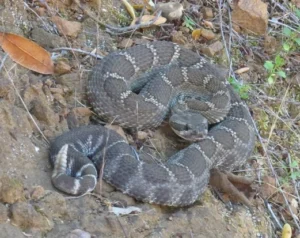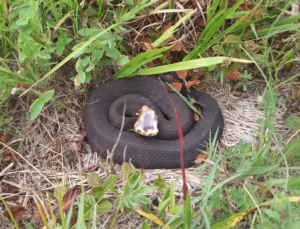Many people fear snakes. This fear usually comes from how they move and their appearance, but mostly from worries about their fangs and bites. Snake venom can be harmful, or in some cases even deadly.
Yes, it is possible to remove a snake’s fangs. However, it’s not a good idea because it can cause serious problems for the snake, and doesn’t make handling them much safer.
Also, in lots of places it could be illegal to remove the fangs from snakes. You could be charged with animal cruelty, pay large fines, or even go to jail.
Even if it is not illegal where you live, it could be against general animal protection laws.
What Are Snake Fangs?
Snake fangs are special kinds of teeth that work like little needles. They are hollow inside, so when a venomous snake bites, the venom enters through the fangs into whatever the snake bites.
Only venomous snakes have fangs. Other snakes have short, tiny teeth to hold their food.

These fangs have taken millions of years to develop and are perfectly adapted for the snake to survive. When someone removes them, they stop the snake from living normally.
How Snakes Use Their Fangs
Snakes rely on their fangs for three main functions:
- Hunting: When a snake bites its prey, the venom works to kill the prey rapidly or make it too weak to fight against the snake. This protects the snake so it can eat its prey, without worrying about the animal hurting it.
- Protection: When a snake feels threatened by an animal, it uses its fangs for protection. The venom in a snake’s fangs causes other animals to think twice about attacking. It’s the snake’s way of saying “Stay away from me.”
- Digestion: The venom in a snake has specific chemicals to start breaking down food before the snake even swallows. This makes the food easier to digest. Without this help, eating becomes much harder for the snake.
Taking away fangs is like removing a person’s hands and expecting them to work normally. It just doesn’t make sense.
Can You Remove Snake Fangs?
Yes, snake fangs can be removed. It is a real procedure that some people do. However, it is not simple or safe.
Removing fangs is a type of surgery. It must be done by someone who knows about snakes. Even then, it is very risky.
How Would You Remove Fangs?
Fang removal is done with anesthesia. The snake is anesthetized first. Then a person uses special tools to either cut or pull out the fangs.
This sounds like it would be easy to do, but it is not. Snake mouths are small and difficult to work in.
Also, the fangs are attached to bone and tissue which means removal can cause damage.
Why Do People Want to Remove Fangs?
Some people think removing the fangs, makes venomous snakes safer to own as pets or to use in shows.
They think that without fangs, they can’t hurt anyone. There are also people who work with snakes in movies and believe that they are simply ensuring safety.

This thinking is wrong. A snake that has had its fangs removed is still a snake.
It will still bite when it is scared or stressed. The snake doesn’t know its fangs are removed, it just knows something is wrong.
Is Defanging a Snake Safe for the Snake?
No, it is not humane for the snake. De-fanging any snake is extremely cruel to the animal. Here’s why:
1. Health Problems
Removing fangs requires surgery. Like any surgery, many things might go wrong.
The snake has to be anesthetized (put to sleep) with some kind of drug, and in fact, some snakes die from this alone.
The surgery itself can lead to infections, especially so if the surgery is not performed by a licensed veterinarian.
Most people who try to remove fangs are not trained medical practitioners, and they most likely are using dirty tools in dirty locations, which makes the process even more dangerous.
The snake’s mouth could become infected with bacteria, and the wounds may not heal properly.
Some snakes have been found to feel pain constantly even after the process; others develop nerve damage that never resolves on its own.
2. Behavior Changes
Snakes are not stupid. They know when something is wrong with their bodies. A snake that doesn’t have fangs is often either very aggressive or very depressed.
Some snakes get aggressive because they feel helpless. They know they can’t adequately defend themselves, and so they attempt to bite more and more.
Other snakes become withdrawn and hide all the time. Some snakes even develop bizarre behaviors such as banging their heads against things or biting themselves.
It’s sad to see a snake go from a calm state to a state of stress and confusion. These behavior problems usually don’t improve over time.
3. It’s Cruel
Many people who work with animals agree that removing fangs is cruel.
The snake suffers, for no good reason. It did not agree to have this done and is only getting injured for the comfort of humans.
De-fanging a snake is the same as cutting the wings off a bird because you do not want it to fly. It’s cruel.
Fangs Can Grow Back
Snakes shed, and replace their teeth (including fangs) many times throughout their lives.
Unlike humans and most mammals, who only regrow our teeth once, snakes continually replace their teeth.

Inside a snake’s jaw, there are four to six fangs, in different stages of development, lined up behind each functional fang.
This means that at any given time, a snake has backup fangs, waiting to come into use.
When you remove snake fangs, new ones will grow in just a few weeks. So, the defanged snake is dangerous again in a short amount of time.
What About Removing Venom Glands?
Some people try to remove the part of the snake that contains the venom (the venom glands).
This is far worse than simply removing the fangs because it is like performing surgery inside a snake’s head.
The venom glands are deep inside a snake’s head and are connected to crucial parts of the snake’s body.
Removing the venom glands can cause great harm to the snake, or even kill it.
Sometimes during the surgery, the venom leaks into the snake’s body and causes infections from the inside.
Is Defanging a Snake Legal?
As earlier mentioned, removing snake fangs is against the law in many places.
You could be charged with animal cruelty, pay large fines, or even go to jail. Even if it’s not specifically illegal where you live, it might still break general animal protection laws.
Before thinking about doing anything like this, check your local laws. Call your city or state offices and ask what’s allowed.
It’s better to know now than to get in trouble later.
Alternatives to Defanging
There are better options to deal with snakes humanely, instead of defanging.
Proper Handling Training
If you want to deal with venomous snakes, learn to do it properly by taking courses from knowledgeable people.
Learn how to use specialized equipment and tools, such as snake hooks and tubes. Familiarize yourself with snake behavior enough to recognize times when snakes are about to strike.
That said, it is not recommended that most people ever try to interact with venomous snakes at all.
There are many cases of experts being bitten, so beginners definitely shouldn’t try it.
Choose Safe Pet Snakes
If you want a pet snake, there are man many beautiful and interesting snakes that are non-venomous.
For example, ball pythons can be very gentle, and come in some amazing colors.
Corn snakes are extremely easy to take care of and are quite beautiful as well. King Snakes are fun to watch.
These snakes are just as interesting as venomous snakes, and they’re safe to handle.
You can get all the enjoyment and experience of having a snake, and not have any danger.
Pet stores can help you choose the right snake for your experience level.
Leave Wild Snakes Alone
The best thing you can do when you see a snake in the wild is to leave it alone. It’s the safest option for you and for the snake.
Most snakes are not aggressive and don’t want to fight or bite you.
In fact, most snakes are afraid of people. When they see us, they’re trying to hide or escape. The only time snakes will bite is when they feel trapped and while defending themselves.
If you try and touch, catch, or kill a wild snake your chances of getting bitten increase.
If you just leave it alone and walk away slowly, the snake will usually move on within a couple of minutes.
Conclusion
Yes, you can remove a snake’s fangs, but you shouldn’t do it.
It does nothing to make the snake safe to handle. It only causes the snake to suffer. The snake will still bite when it is frightened, and some snakes can still inject venom with broken fangs anyway.
Snakes are amazing animals that play an important role in keeping nature in balance. They eat the rats and mice that would otherwise become pestilence upon the earth.
If you want to share the world safely with snakes, education is the way. Understanding snakes is far better than trying to change them.
Featured image credit: David Martin (CC BY-NC 4.0)
Hi, my name is Ezra Mushala, i have been interested animals all my life. I am the main author and editor here at snakeinformer.com.

